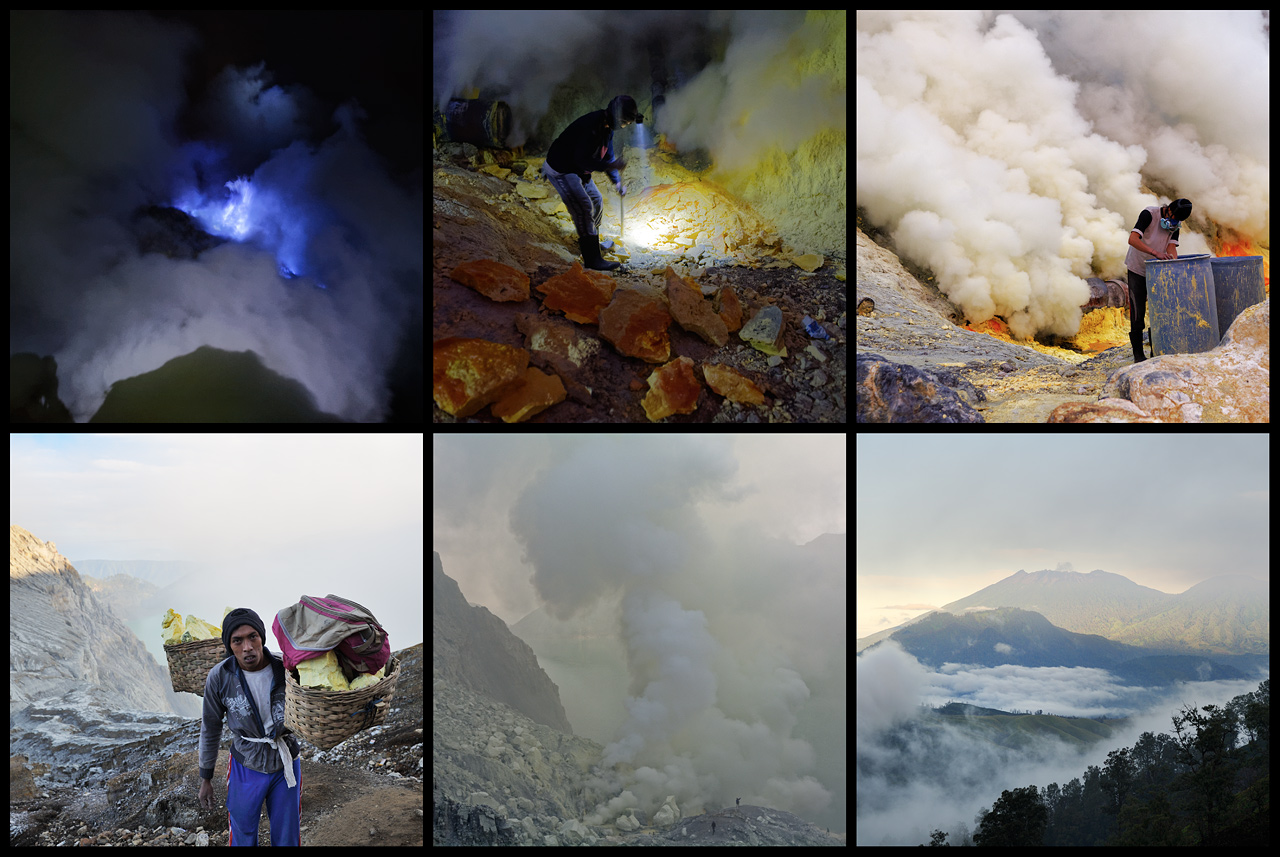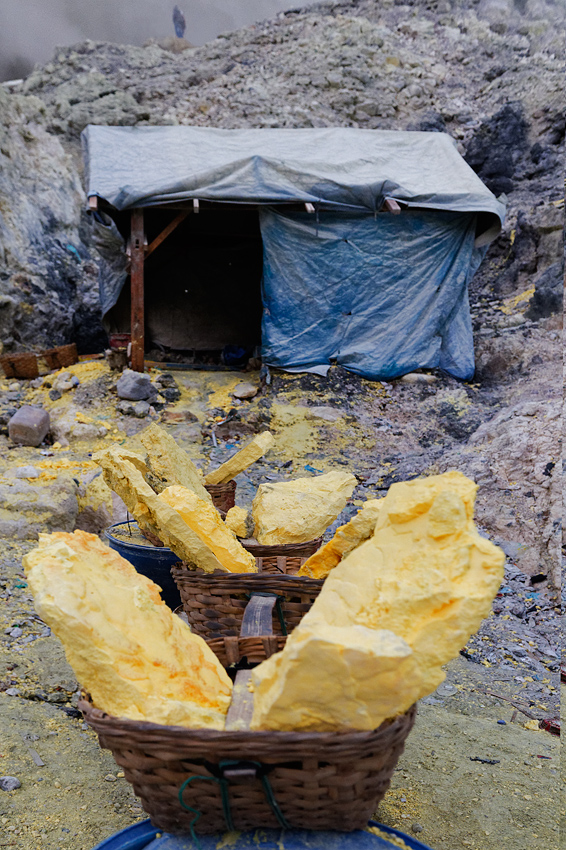|
| Hint! All small images in this documentary can be enlarged and viewed in a new window |
|
|
|
| It
is 4 in the morning and still pitch dark when we arrive on top of the
crater’s edge. After four kilometers and less than two hours, we
have covered an altitude of about 500 meters from the starting point.
This is not too much, but in part, the stretch was quite steep. The
nocturnal view inside the crater is fascinating, even when all one sees
is that it goes very deep down and the bottom is fuming and smoking
wildly. But one can also, from time to time, see a blue flame down
under from a distance: the “Blue Fire”, as the natives call
it! From here, the crater’s edge, one can only go further if one
has paid in advance and has a breathing mask. It is all checked, even
at night. The way forward is steep, rocky and arduous. In the distance
there are traces of a few lights of the tourists who have already gone
ahead on this path. Again one still needs about 45 minutes to reach the
crater lake. Now and then we come across one of the fully loaded sulfur
carriers. They are breathing heavily and naturally they have the
absolute “right of way”. We tourists have to clear the way
in time. They are coming upwards from the sulfur mines, which are
located inside the volcano craters. The tension mounts, definitely! |
|

|
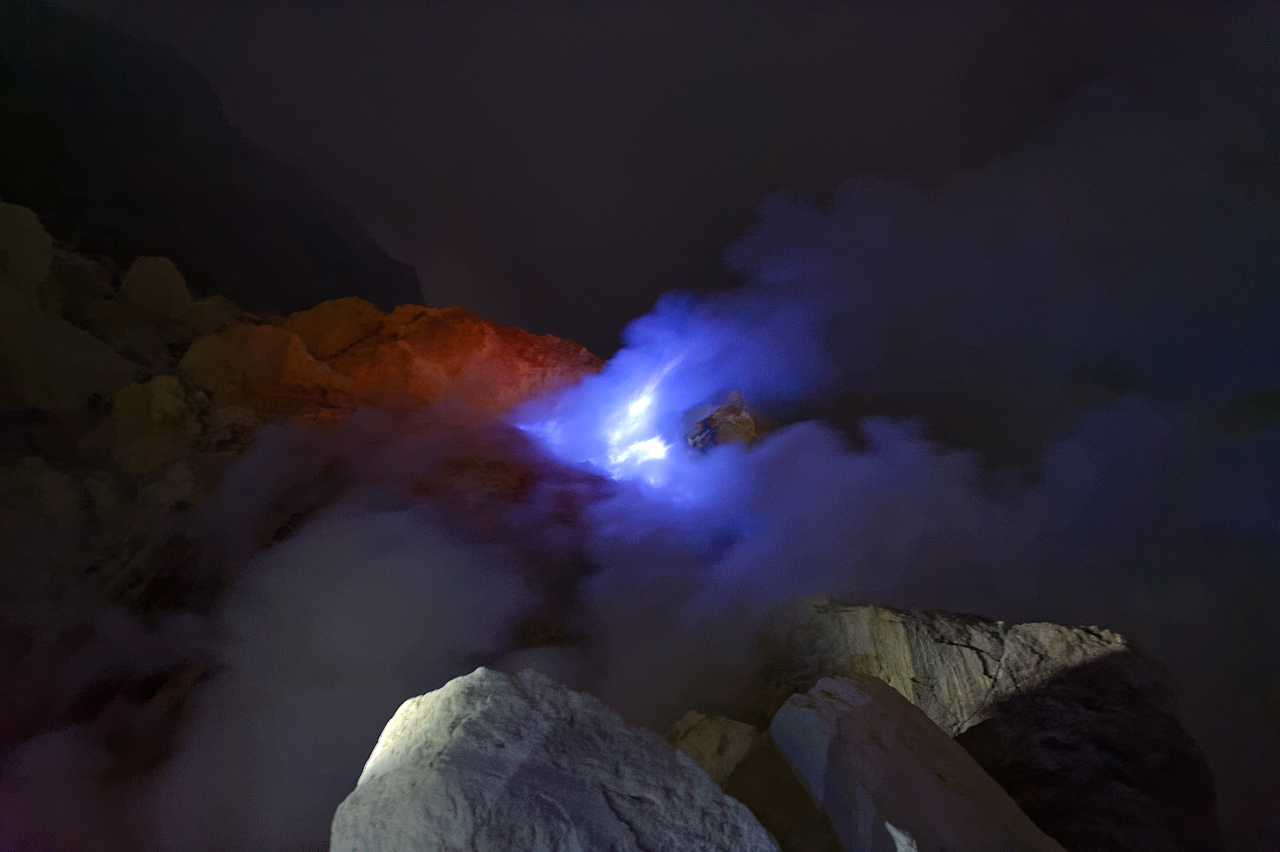
The “Blue Fire” |
|
|
|

|
| During
the nocturnal hikes I reflected upon what drives us, what the real
fascination is that especially active volcanoes wield on us humans? I
believe that we humans get here a very distant sense of the geological
formation of the earth, for the period of a million years, and for the
primal forces that our world and we have given rise to. Here, on this
open interface between the interior of the earth and the superficial
world we can feel the prevailing forces are greater than anything
humans can dominate and control, this is the interface towards the
unfathomable, towards pure elemental force, towards the origin of life.
That is very inspiring! |
|


|

Active neigbouring volcano: Mount Bromo |
|

|
| “Mount Ijen”
(pronounced: (Idsháyn) constitutes an entire volcano complex in
the east of the Indonesian island of Java. In its immediate vicinity in
the southwest, a 3,332-meter high volcano “Gunung Raung”
has sprung up. A little further west from it is the famous
stratovolcano (composite volcano) Bromo, which is 2,329 meters high and
one of the most active volcanoes of Java. The most special at Mount
Ijen (2,386 meters) however is the big lake, “Kawah Ijen”
in the inside of its crater, which consists of acidic, turquoise
coloured water, as well as one of earth’s most active emissions
of steam (solfatara) containing sulfur with enormous hot steam outlet
points (fumaroles). |
|

|
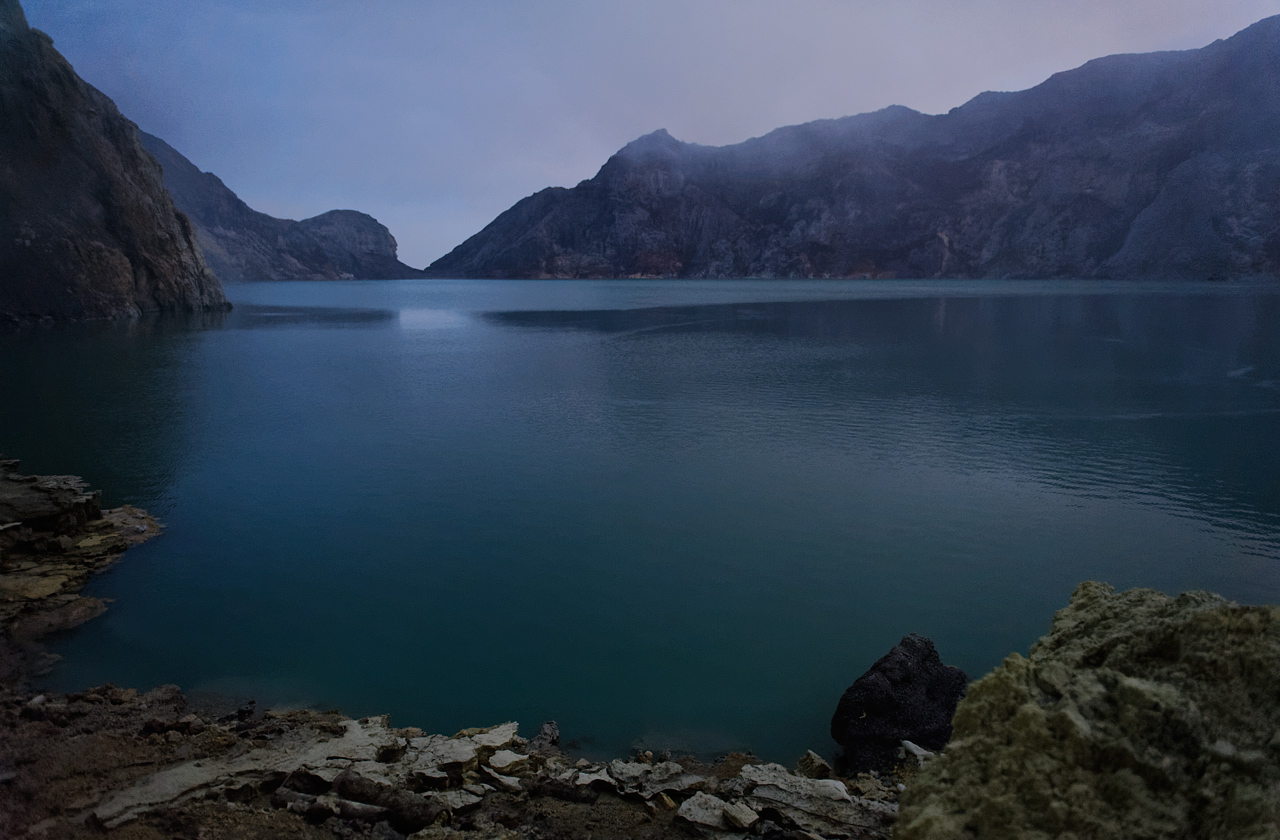
"Kawah Ijen” shortly before sunrise |
|

|
| Due
to its acidic water and violent emission of the steaming solfatara, the
lake is termed by geologists as “the biggest acid barrel on
earth.” It is 960 m long, 600 m wide, and about 250 m deep; it
gets its blue-green colour through its high content of alum, sulfur and
gypsum. The water of this lake is extremely acidic; analysis has
determined a pH value of under 0.3, pure water of 22° C usually has
a pH value of 7. The temperature of the lake fluctuates; in the
long-term however, it is slowly rising. It was estimated to be 32°
C in the year 2000 and in the following years 35° C to 45° C.
The highest upward deflection so far has been 48.1° C in the year
2004. The level of the crater lake is at a height of about 2,120
m. |
|

|
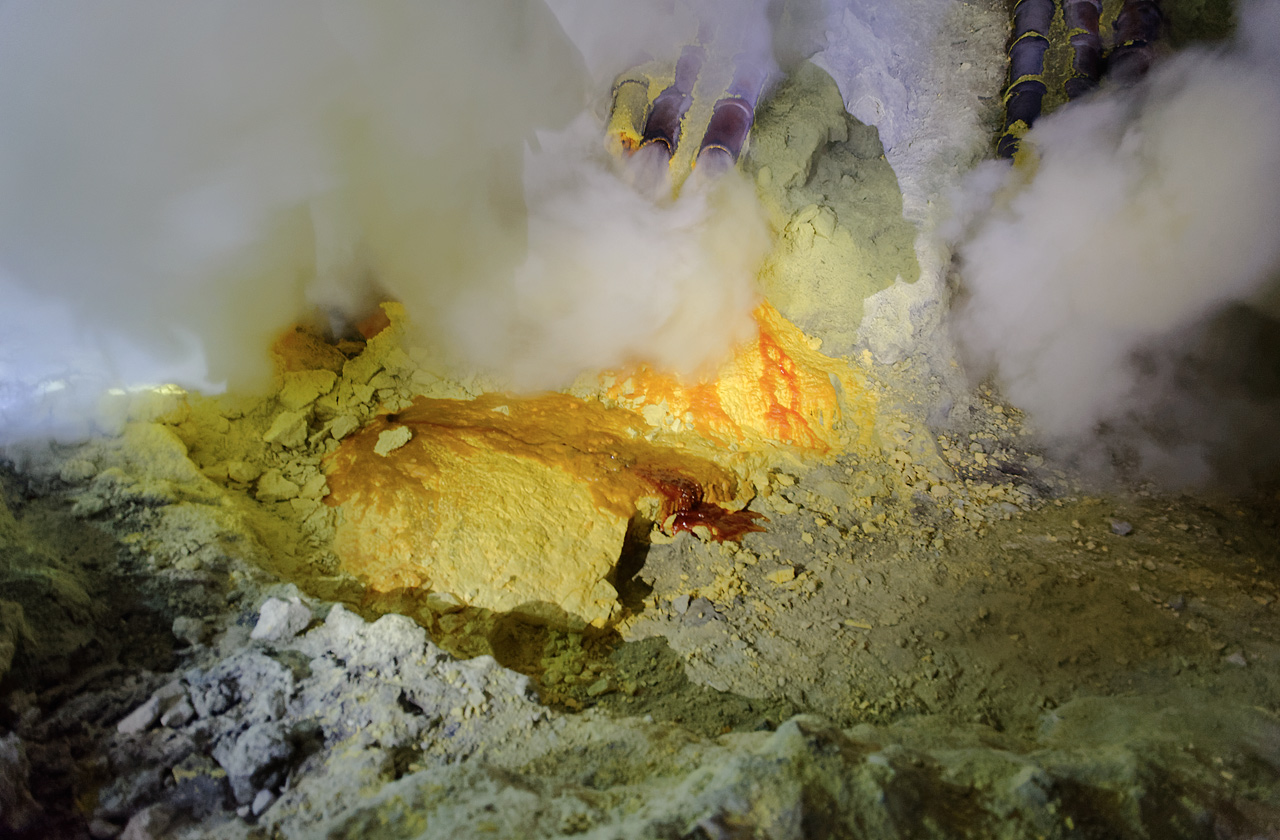
"Controlled solfatara” of the sulfur mine (at night)
|
|

|
| On
the southeast bank of the lake is the greatest active solfatara. Hot
fumaroles of up to 250° C form the largest sulfur accumulation of
Indonesia; its sulfur vapour has in the meanwhile formed deposits about
10 m thick. A sulfur mine was opened in 1968 on this sulfur-rich outlet
point, in which even today sulfur is mined. The hot sulfur vapours are
passed downwards through approximately 10 m long sloping pipes, where
the sulfur escapes in the form of 120° C hot, viscous, and
red-orange coloured mass. After cooling and hardening of the sulfur,
which in the meantime has transformed into a luminous yellow colour,
the workers break the sulfur in larger pieces with iron rods. |
|

|
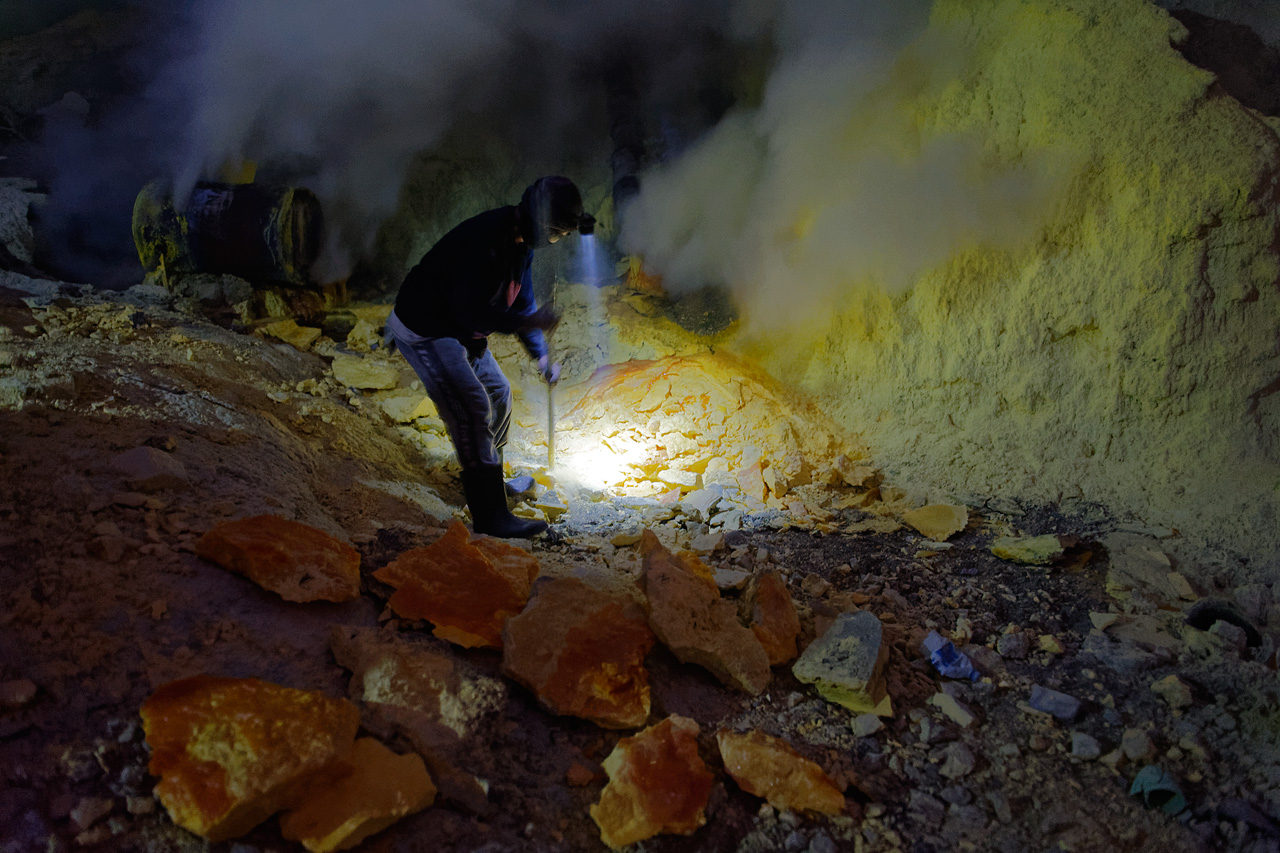
Sulfur miner on Mount Ijen (at night) |
|

|
“Hati
hati” – “Watch out”, shouts a worker and rams
the iron rod in the sulfur till the porous yellow rock splinters. A
gust of wind blasts a cloud of sulfur over him, he coughs a little but
continues further; small and big pieces of broken sulfur lie around all
over. As far as I could make out, these sulfur crushers, who are
continually covered in the poisonous sulfur vapour, partly do not wear
any masks for protection, only moist cloths. How good these really are
for protection, I do not know; at any rate they do not look reassuring,
only much too improvised. The company owning the sulfur mine should
really not save on this important health aspect.
Time and again, one hears the workers coughing, nothing is being said
and despite the substance or the breathing mask, the vapours penetrate
into the airways of respiratory tract. From time to time it so happens
that someone keels over and loses consciousness for a short while,
explains our companion, Fendrik. “Because of Ijen’s
breath”, they say then, as if the mountain had a soul. But out of
fear that it would be interpreted as a weakness, they speak about it
reluctantly. It is almost impossible to photograph here, light and
contrast are poor, or even to focus properly, especially when the wind
blows the sulfur vapour over us! On the edge of this action, a sulfur
miner pours the hot and still liquid sulfur into small baby shaped
sandboxes, which harden and are then sold to tourists for a few Rupiah,
as yellow flowers or small airplanes. |
|

|
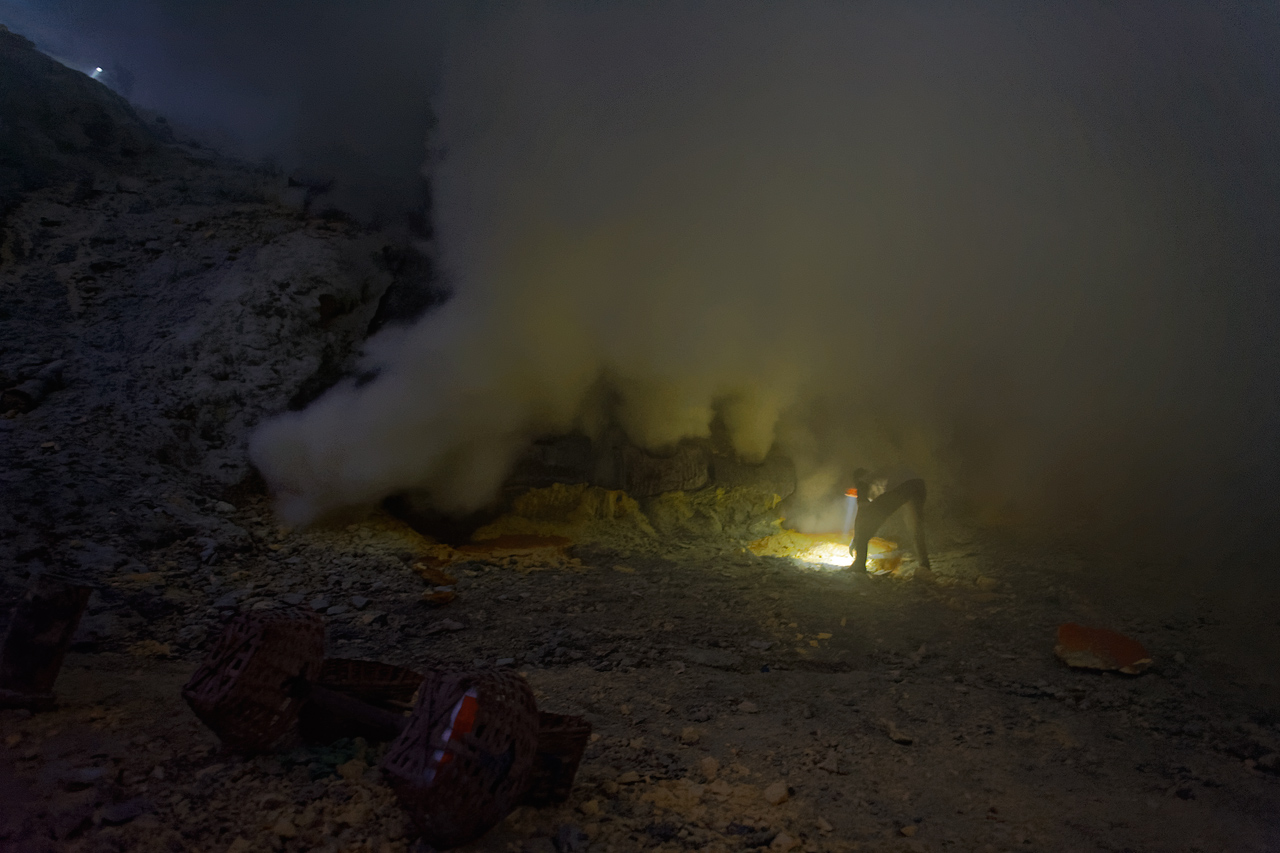
In the middle of “Ijens Breath” |
|

|
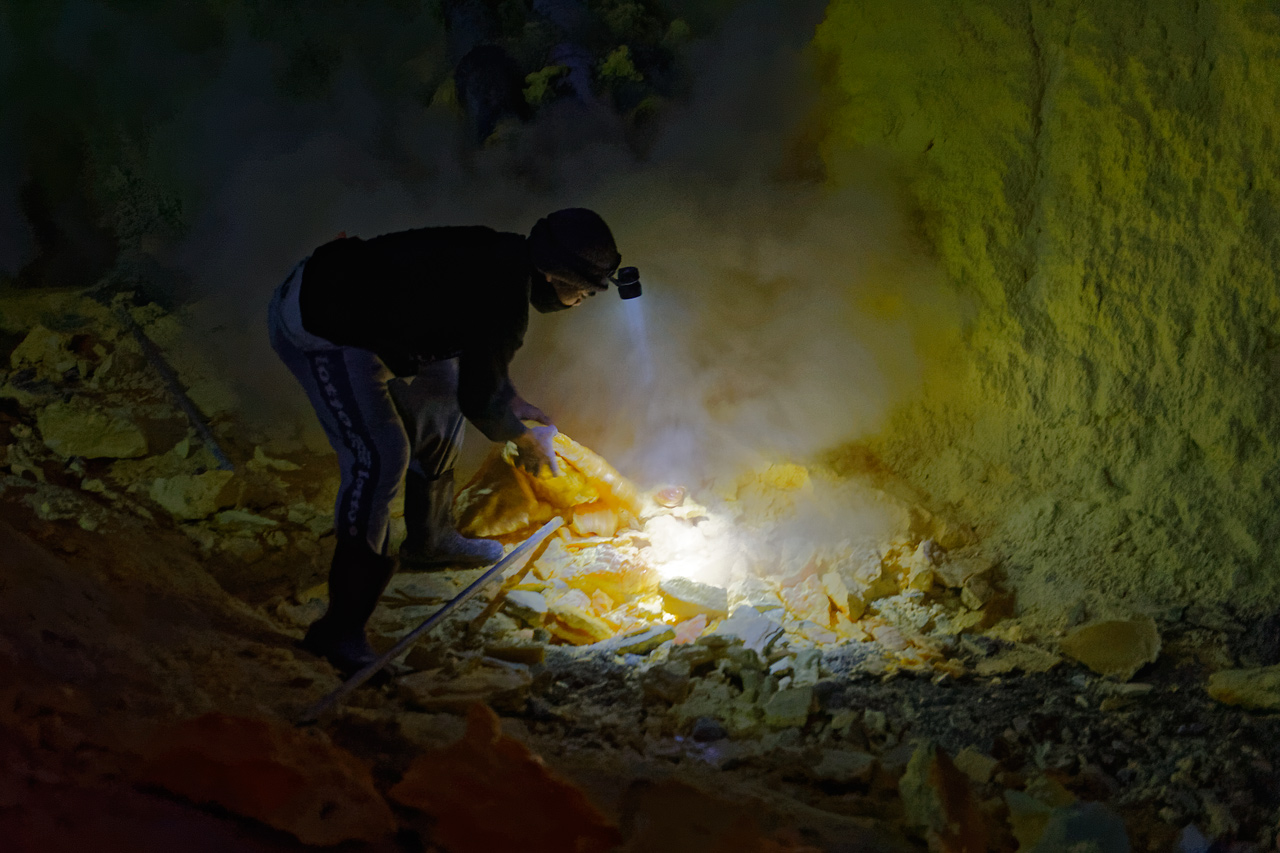
A moist cloth for protection
|
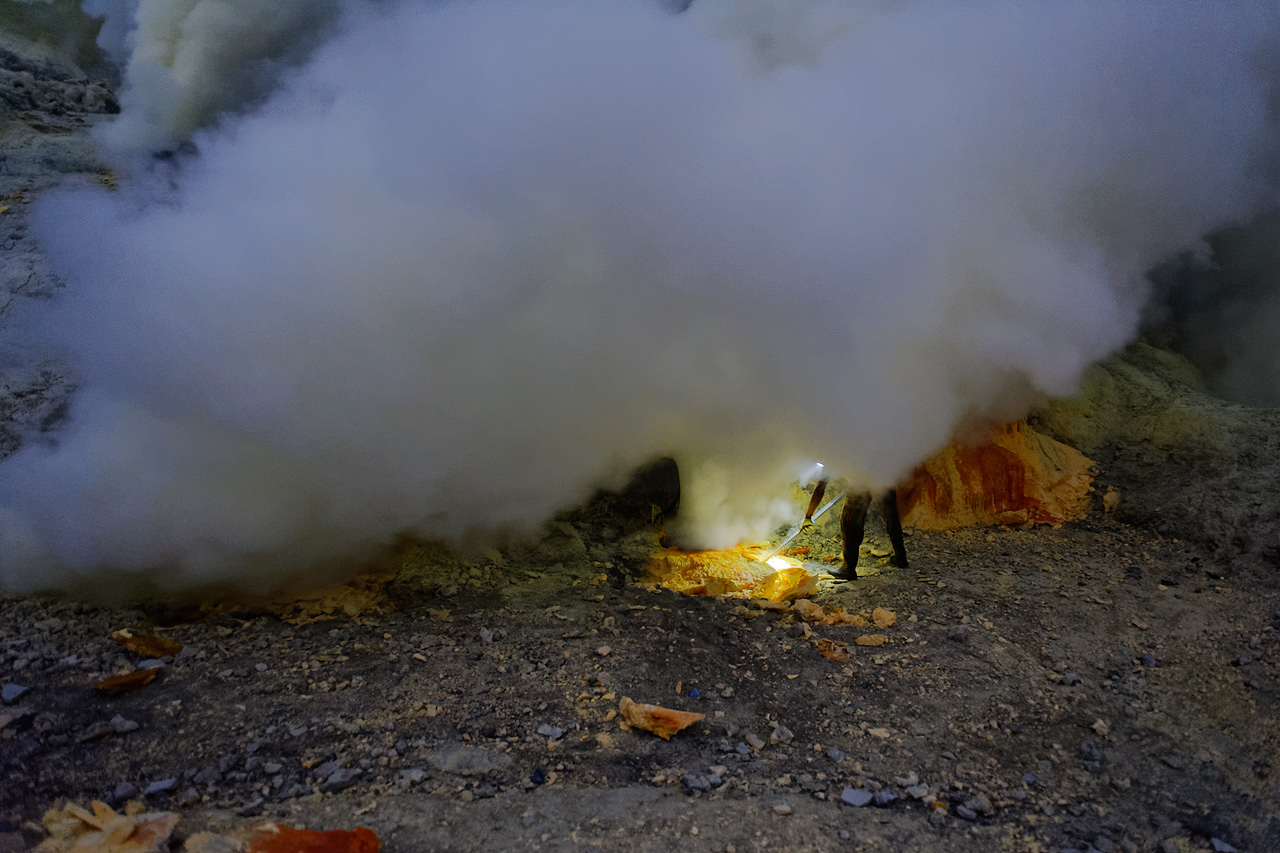
Often the wind covers the workers in a cloud of sulfurous gas
|
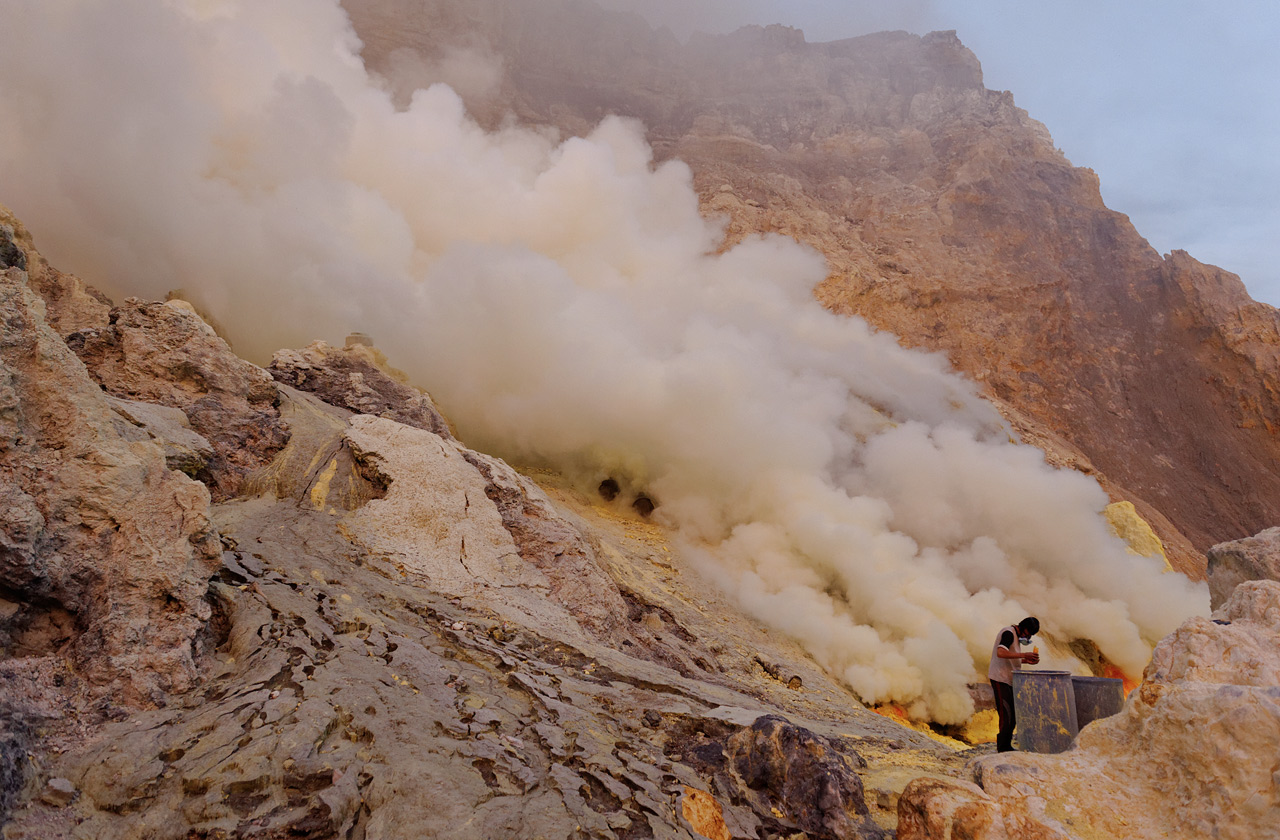
“As if it had a soul” |
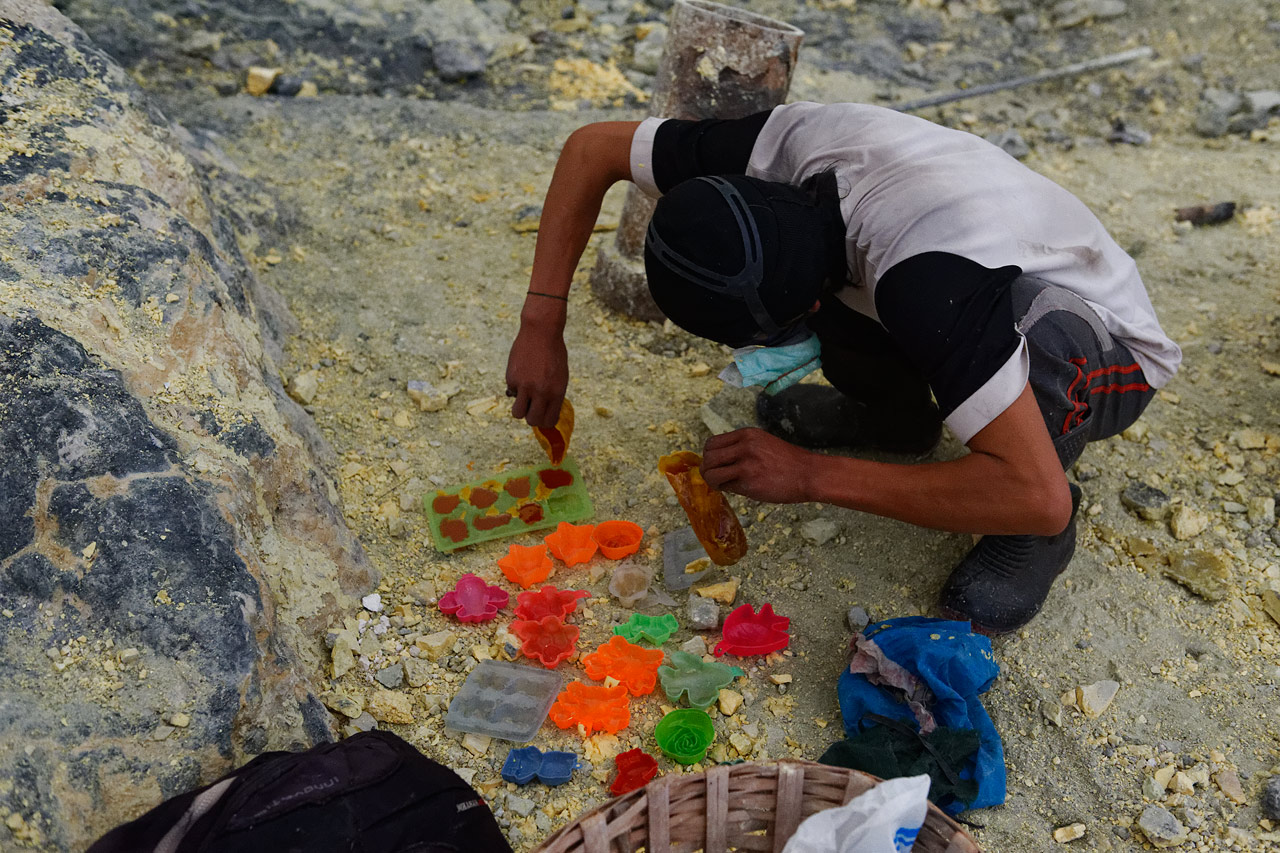
Babyish sandbox shapes
|
|

|
| Above
the mining site, the gaseous sulfuric acid overheats occasionally and
ignites by itself and then burns a deep blue, with up to 5-meter high
flames; the sulfur then cools down and furrows into the sea. This very
rare natural spectacle is seen best in the dark and it is truly
exciting to watch, but just as difficult to photograph. However, one
observes very quickly that one should not be in this environment. It
boils, hisses and bubbles, the changing wind pushes the cloud of sulfur
continually on the face and despite the breathing mask it burns in the
lungs. |
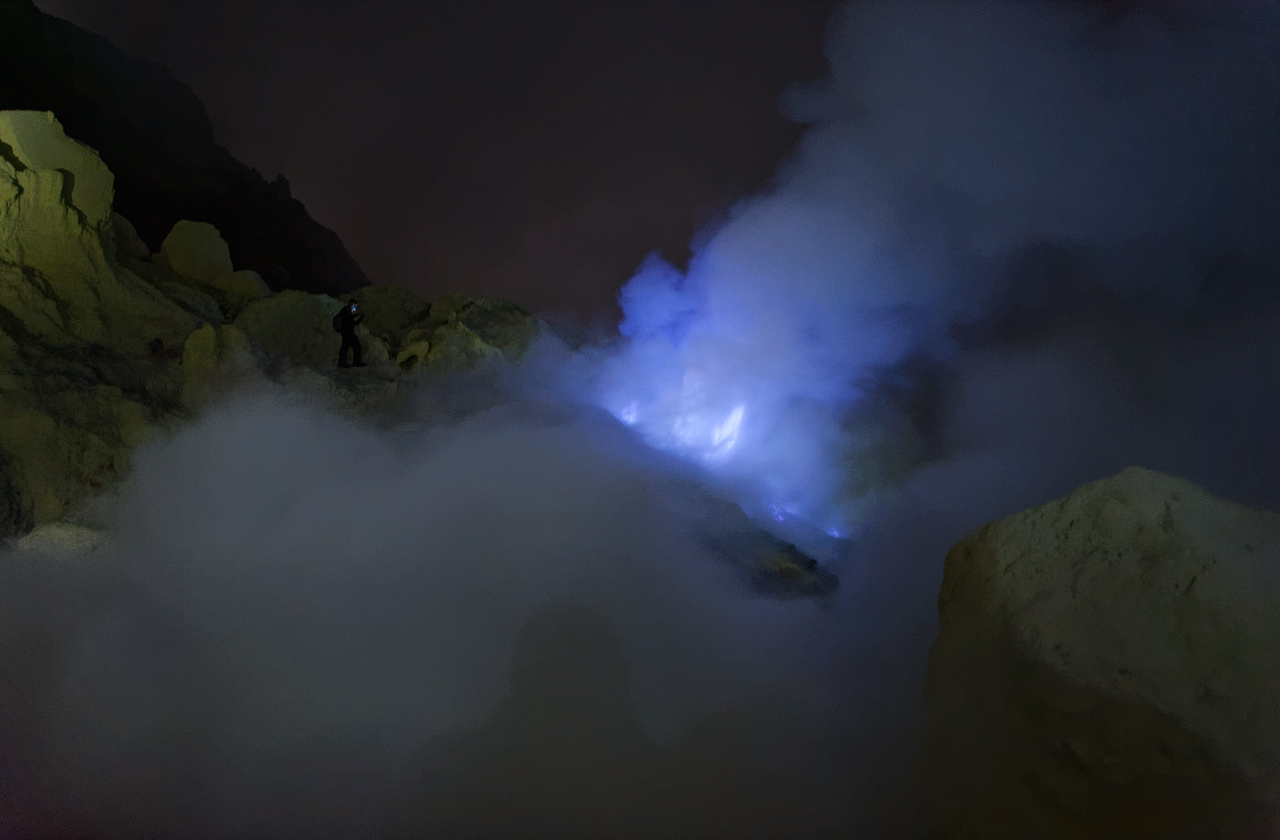
The Blue Fire ...
|
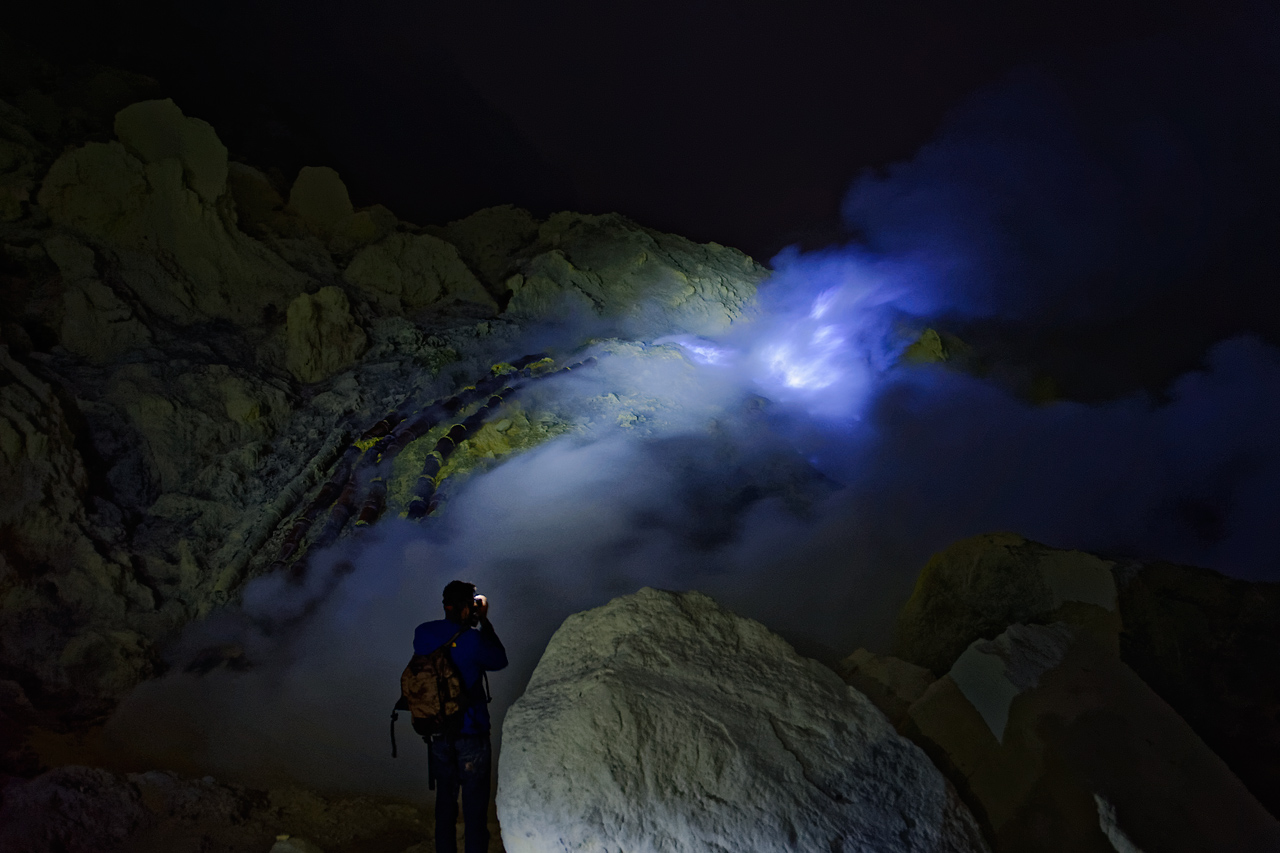
... attracts the tourists especially at night.
|
|
|
|
|
For those who want to know exactly (and for my brother Volker):
In the escaping vapour, the exhalation of hydrogen
sulfide (H2S) is at a temperature of up to 250° C. The hydrogen
sulfide is oxidised on contact with air and it results into deposits of
elemental sulfur, and also partly iron sulfide, as well as in the
formation of sulfurous acid (H2SO3). This sulfurous acid can also cause
the surrounding rock to deteriorate and is also dangerous for the
workers. In the Middle Ages, such sulfur deposits were, for e.g. in
Iceland in Námafjall, an important source for the production of
gunpowder in the whole of Europe.
|
|
|

|
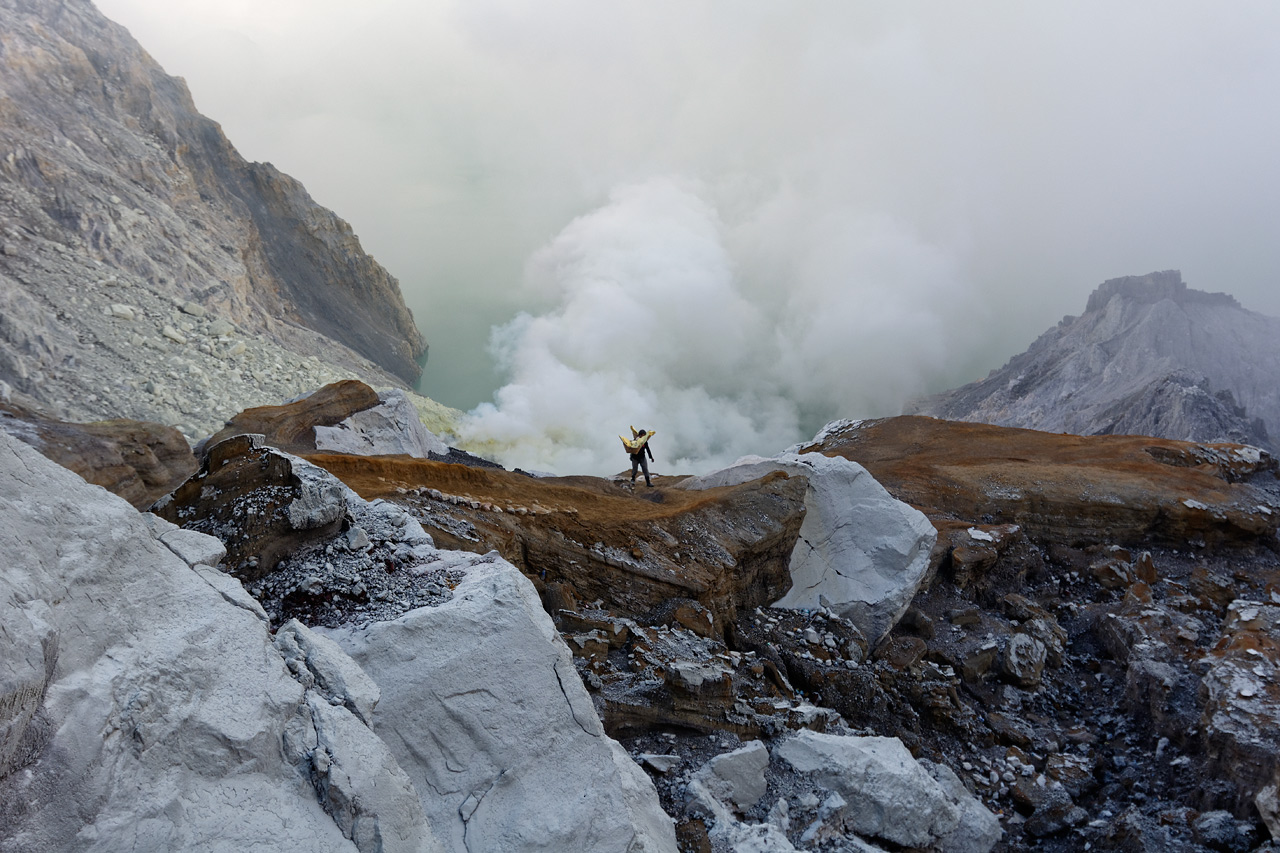
Sulfur carrier on Mount Ijen |


|
 |
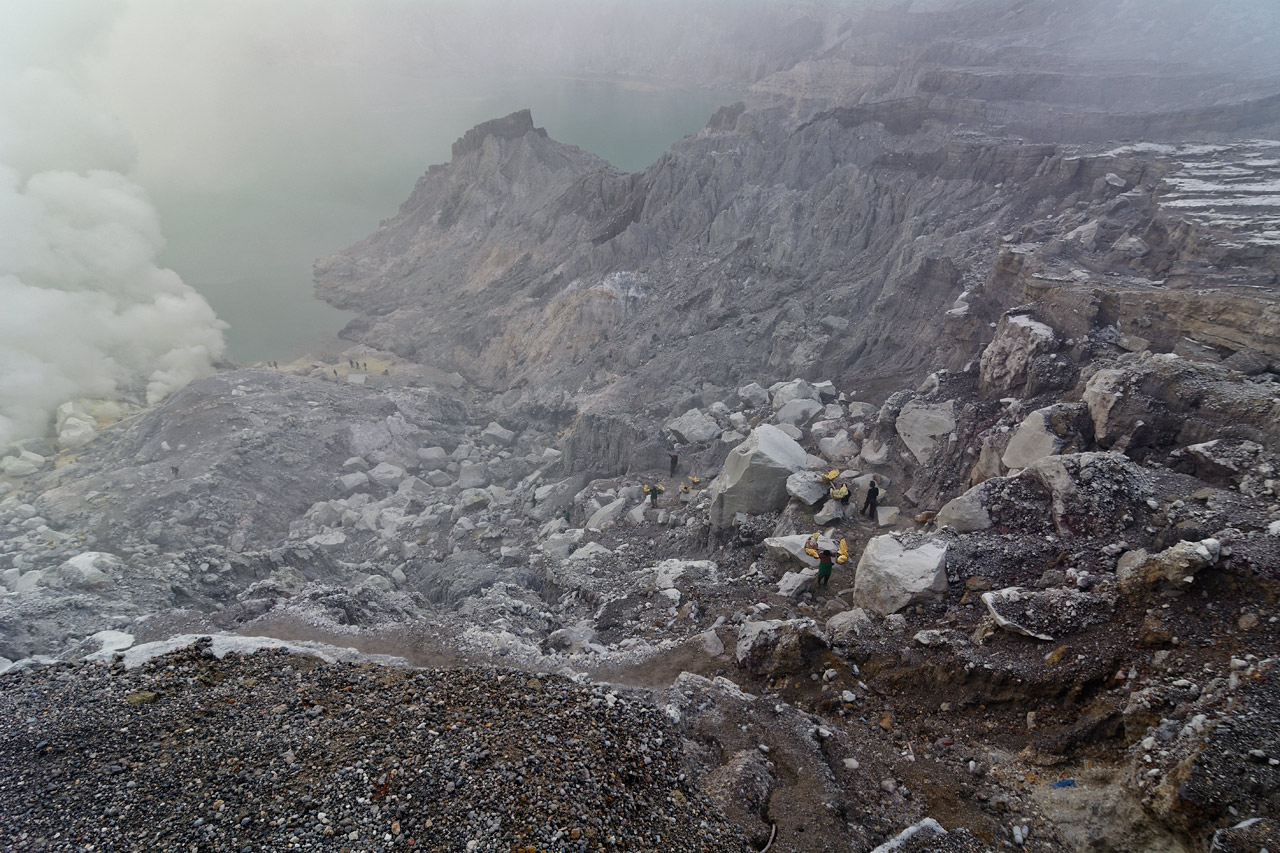
Sulfur carriers on Mount Ijen - like yellow dots
|
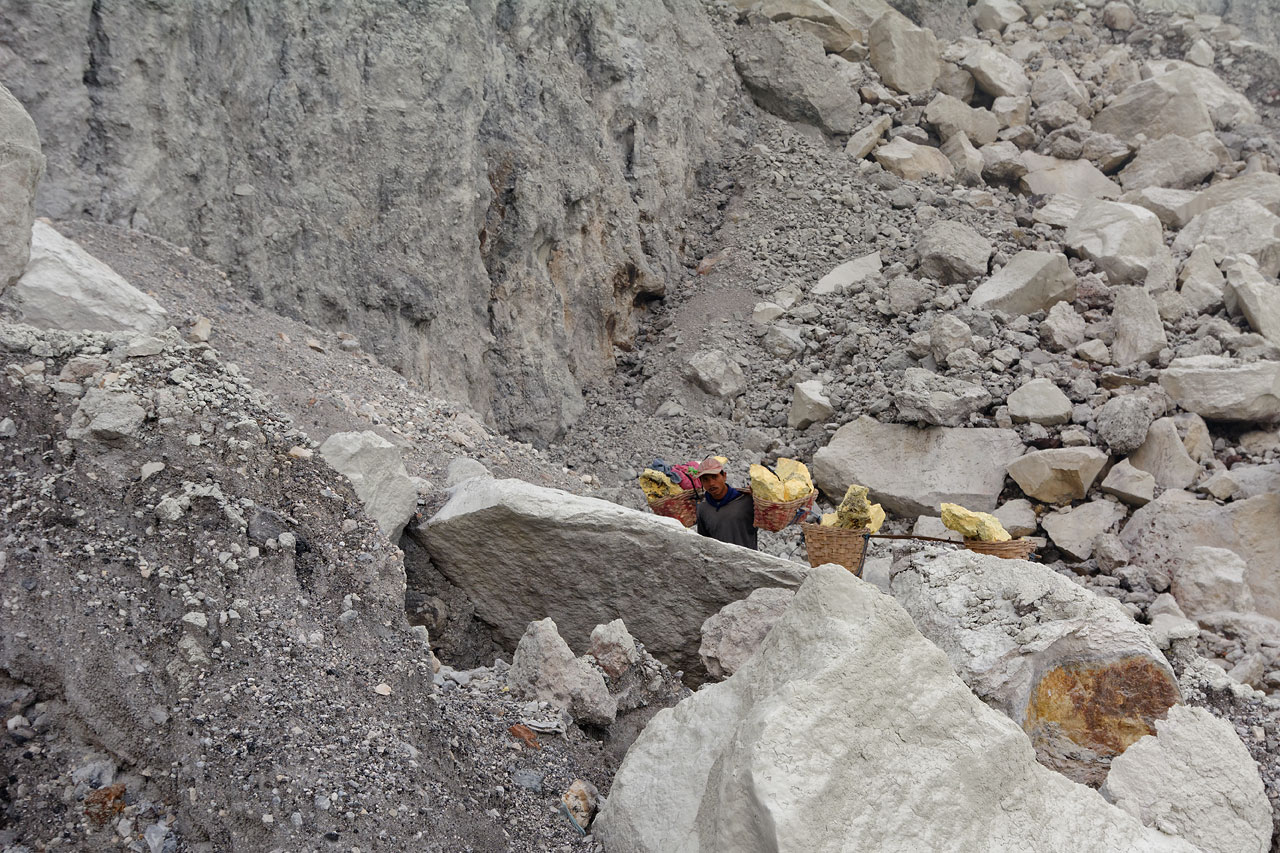
With teetering steps they go upwards slowly
|
|

|
| The
broken sulfur is transported from the crater of the volcano by the
sulfur carriers, a few of whom we met during our nocturnal climb into
the crater. This is real hard work and thanks to Fendrik, we were able
to get some information from these people, as besides a couple of words
they do not speak any English. All together 220 sulfur carriers work
for the sulfur mine on Kawah Ijen. At the age of 13 one can take an
entrance examination, which entails climbing up the mountain and then
down again from the other side, carrying 40 kilos. There is a temporary
contract for this, a fixed transfer into the “Guild”, but
only when one can heave 60 kilos per delivery up and down the mountain.
The strongest among them manage over 90 kilos per delivery! Presently,
the workers get 1,000 Rupiah for 1 kilo sulfur (6/2015: 1 Euro = 15.109
Rupiah). As a rule, the workers go down into the boiler twice in a day,
so that they carry, shall we say, 80 kilos and earn 10.57 Euro per day.
That is four or five times more than a rice harvester or coffee picker
earns. But half of it goes to the sulfur miners down in the sulfur
mines. Nevertheless, it is comparatively a good pay, so the few free
jobs are in high demand. In the long-term, however, the health of the
workers is ruined. Their life expectancy is ten years lower then the
average population – about 50 years, says Fendrik. |
|

|
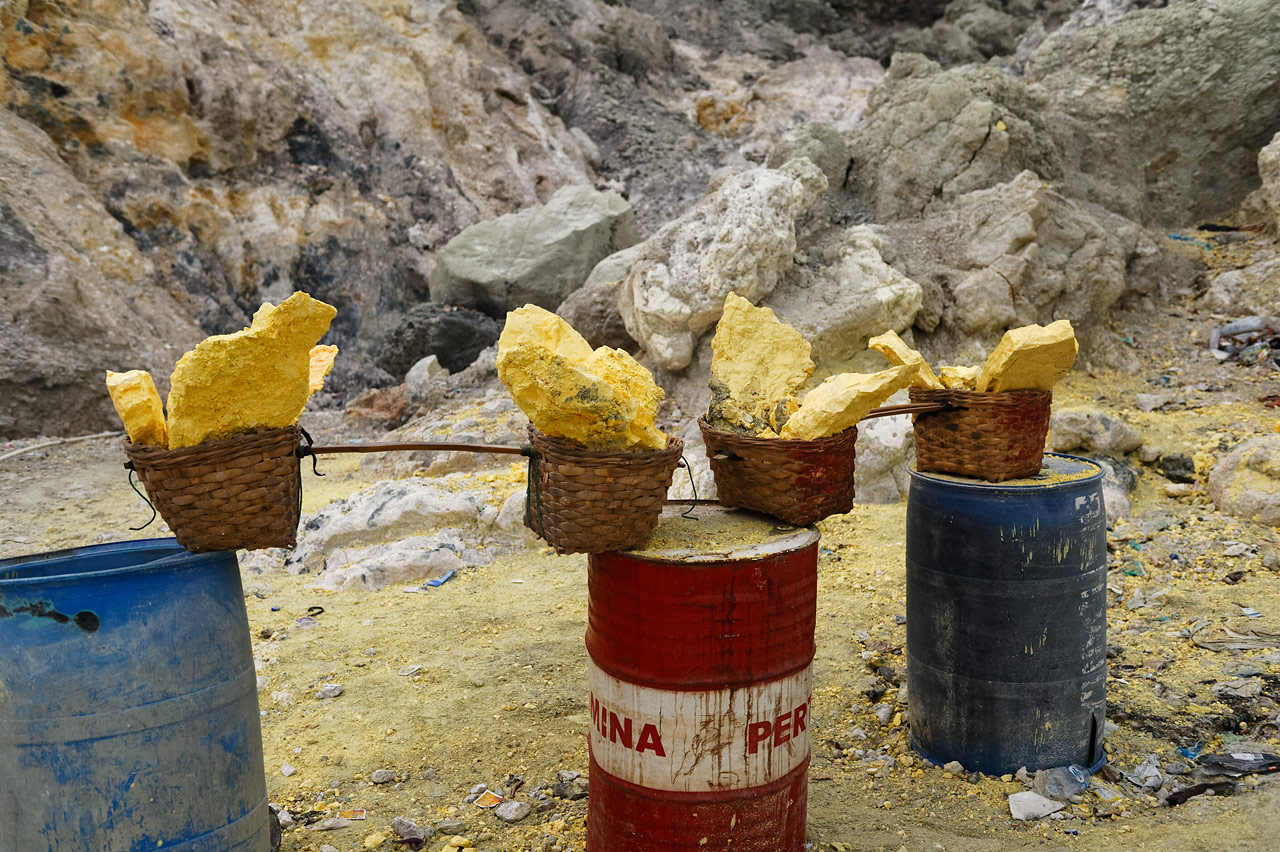
These heavy baskets must be carried at this height. The workers carry between 70 and over 90 kilos up and down the mountain.
|
|
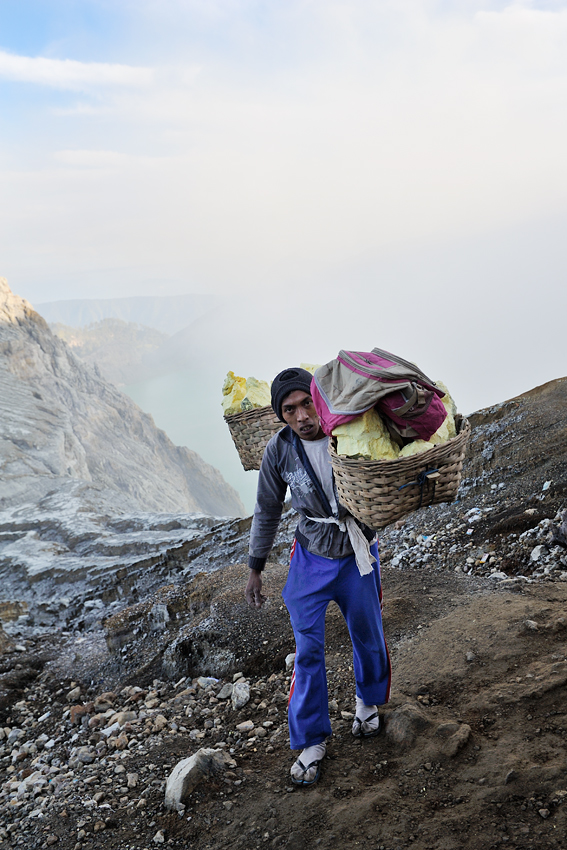 With flip-flops and toe-socks!
With flip-flops and toe-socks!
|
|
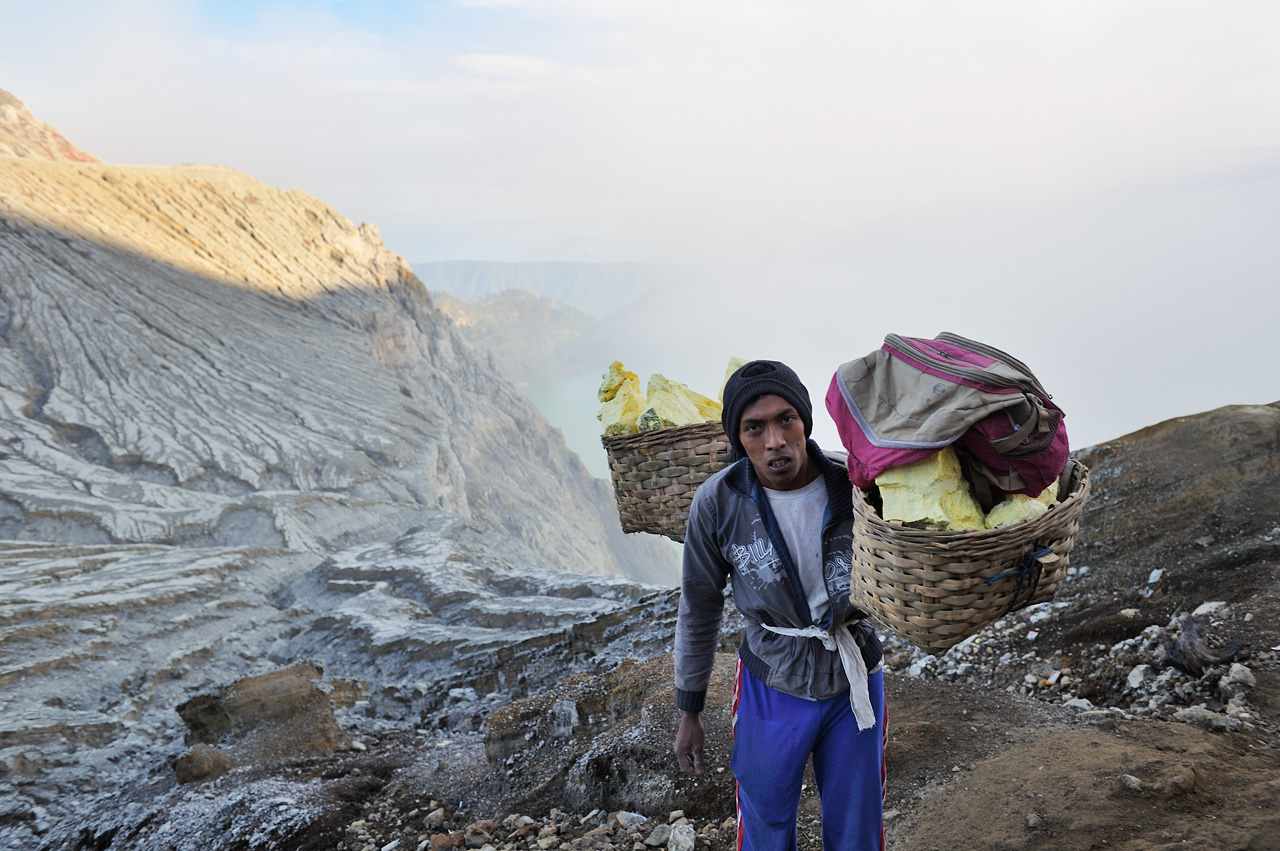
Sulfur carrier on Mount Ijen. The effort is written all over his face. |
|

|
| “In
a month we work for 10 to 15 days in the sulfur mine, the rest of the
month we spend with our families; many of us have another job as well,
for e.g. in the sugar factory,” one of the sulfur carriers tells
Fendrik during a break on the crater’s edge. Day and night, the
workers heave their load upwards, in the nights it is pleasantly cool
and not so overcrowded as in the day. The sulfur haulers transport the
broken sulfur pieces in two bamboo baskets over the 200-meters high
crater’s edge to the valley. The baskets with the sulfur pieces
hang on a strong rattan pole, the weight is then well balanced. Their
passage to the top moves slowly, teetering lightly in rhythm of the
steps, the step in flips-flops and toe-socks or in large rubber boots
is concentrated and firm. The heavy weight moves forward step by step,
and is heaved up slowly but surely. Through the see-saw movement, they
relieve their shoulders for a moment, which probably makes the duration
of the journey a bit more bearable. At definite and distinct gaps, the
load is placed on the other shoulder in a rapid rotational movement and
in similar distinct gaps short breaks are taken. That is why time and
again one sees full baskets parked somewhere or the other. Most of them
are happily smoking a cigarette… approximately seven to eight
tonnes of sulfur per day are hauled to a collection point at the foot
of the mountain. |
|
|
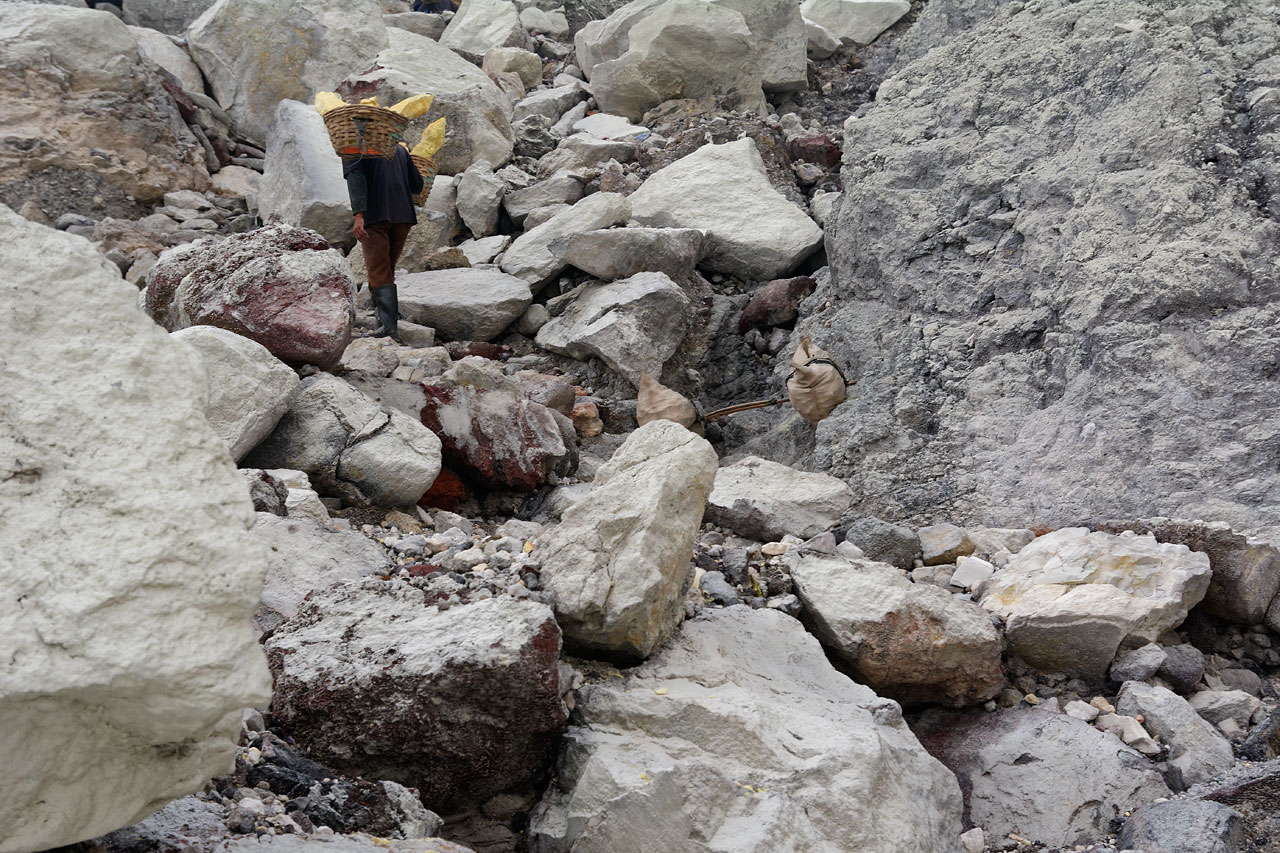
Sulfur carrier on Mount Ijen. One who does not have a basket, uses sacks. |
|
|
| On
the way down, after about a kilometer, we come to a weighing station.
Here, the rattan poles are hung precisely in the centre on a hook and
the exact weight is determined. The sulfur haulers watch out to ensure
the weight is correctly read, because their future payment depends on
it. They get a receipt for the weight they have carried, for which they
will receive payment later. Thereafter they carry both baskets further
down where these are then loaded on to a truck. The walking technique
of climbing down is totally different from climbing up. Here they take
short, quick steps three at a time, it looks like they are trotting
lightly or nearly running. They relieve their knees and muscles with
each step so that they do not slow down at every step. |
|
|
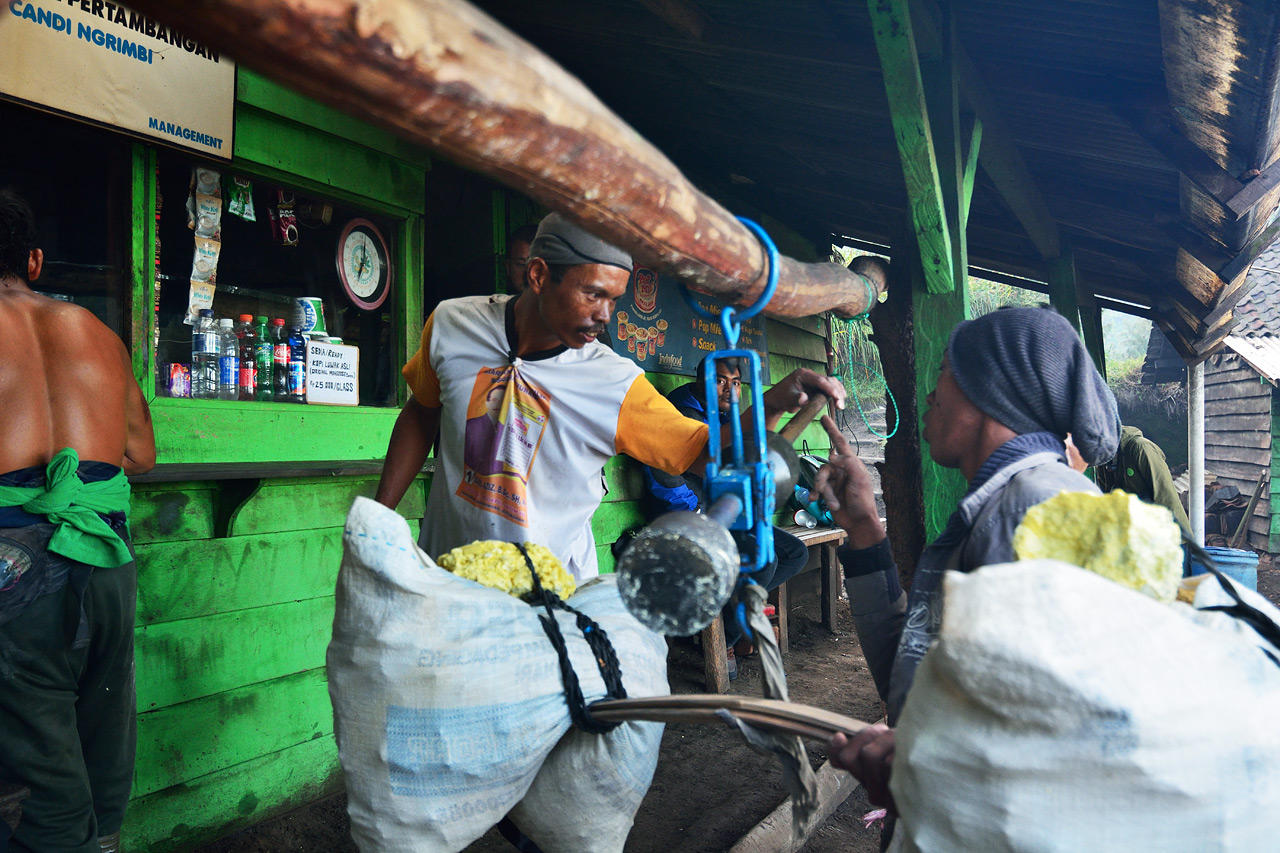
Sulfur weighing station |
|
|
| The
truck brings the sulfur to the nearby town, Licin, to the company
called PT Candi Ngrimbi, which has bought the license for the mine from
the government. In the factory, the sulfur is heated in an oven, that
is, it is liquefied and then cleaned off of stones, earth and sand. The
company buys and works on the sulfur here only because it can obtain it
at a cheaper price locally than buying it on the global markets. Sulfur
is a waste product of natural gas and crude oil distillation and
therefore it exists in abundance. The cleaned sulfur is then sold to
the sugar refineries in the country, where it serves to bleach the
sugar. Even the pharmaceutical and chemical industries located at a
distance of about 200 kilometers in the provincial capital Surabaya are
buyers, for e.g. for the production of medicament and also
fertilizer. |
|
|
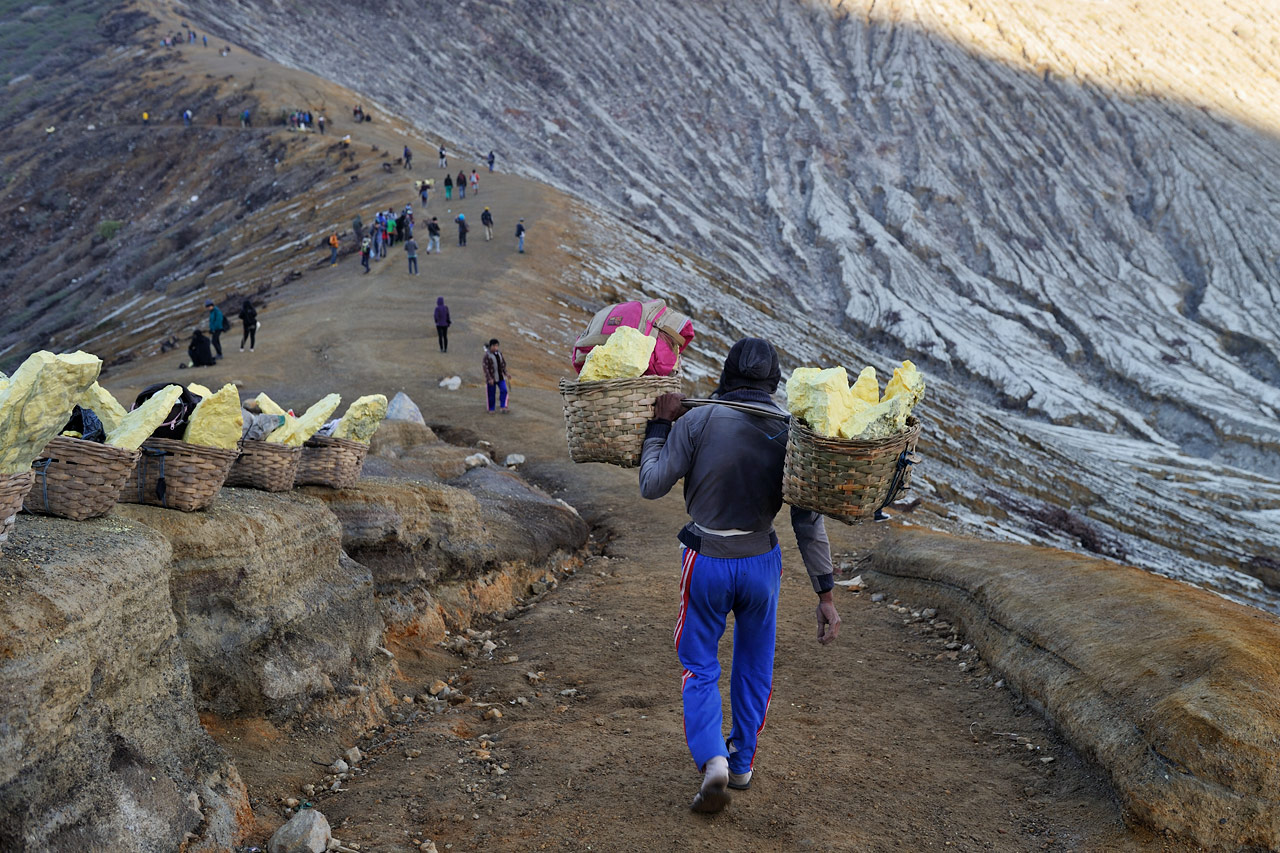
Along the crater’s edge, down from the other side - through the middle of the tourists |
|
|
The
Ijen volcano is considered, all in all, so dangerous and unpredictable
that danger zones of diameters 8 to 12 kilometers have been set up. The
bigger concrete danger emanates from the turquoise-blue lake, which
covers two thirds of the crater ground, because the volcano vent on
this ground is especially unpredictable:
• 1817 - a huge eruption of a fountain of sludge catapulted out of
the lake and buried innumerable people and fields under it.
• 1976 - 49 out of 50 sulfur workers were suffocated due to a gas eruption.
• 1989 - further 25 sulfur workers died because of a gas eruption. |
|
|
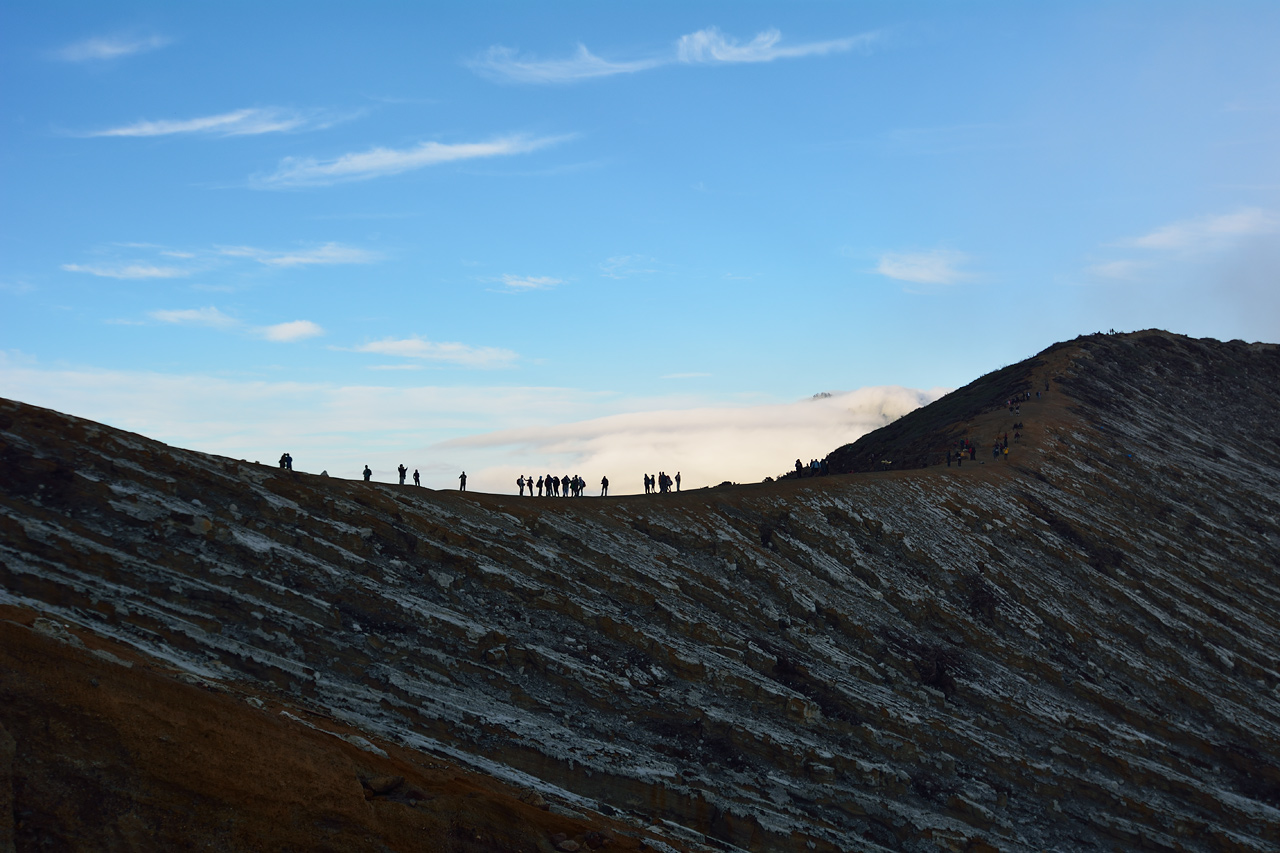
The crater’s edge – Mount Ijen |
|
|
| Previously,
after heavy rainfall, the acidic water of the crater lake flowed over
the edge of the crater and caused severe damage to the rice fields and
sugarcane plantation in the north coastal plains. That is why a sluice
was built in 1921, which prevented the arbitrary flow of acidic water.
The walls of this sluice are made up of sulfur blocks, because no other
construction material can withstand the acidic water for a longer
duration. |
|
|
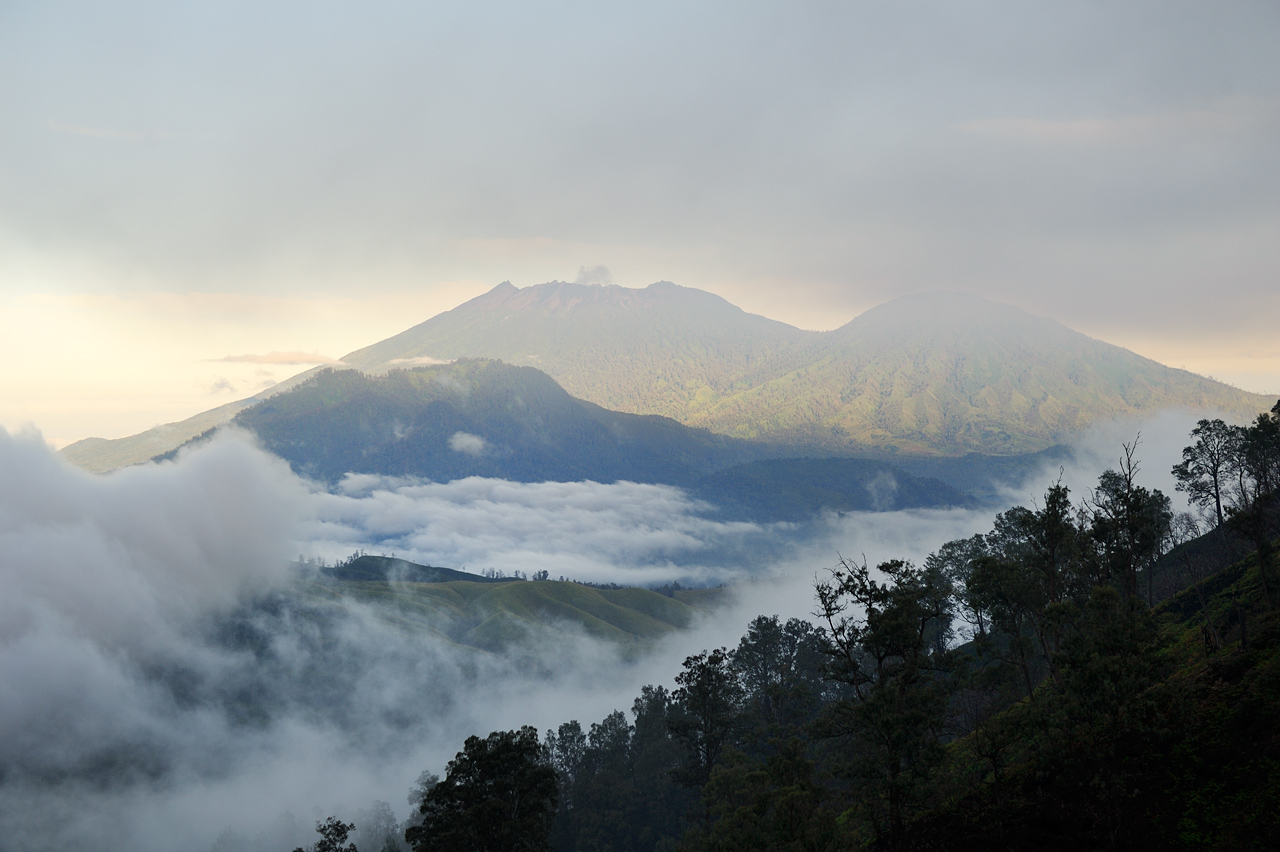
A view of the neighbouring volcano “Gunung Raung”
|
|
|
| Sometimes
it is good and also right that man embraces nature. Actually however,
he has nothing to look for in such a place, neither as a worker nor as
a tourist. And still the entire volcano world wields upon us this
unique fascination, even though it is so dangerous. Or perhaps because
it is indeed so dangerous? Because it brings us close to our Creation,
or because the universe allows us to be an inconsequential witness? |
|
|
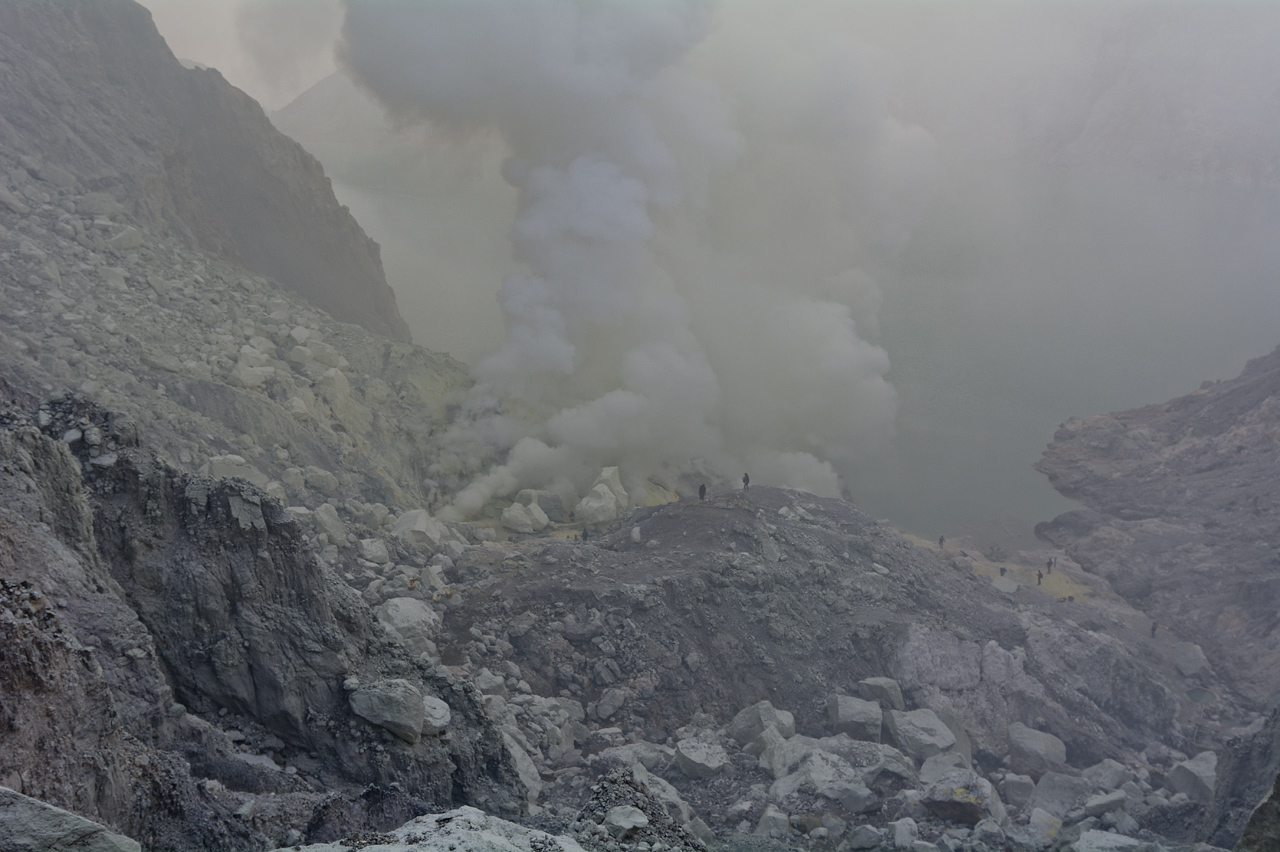
A look back into the crater of Mount Ijen
|
|
|
| When
one stands there and looks back into the crater, or when one sees the
blue flame, the sulfur that has ignited because of over-heating, and
which flows from deep inside the earth, one experiences not only a
beautiful spectacle of nature, but also first hand the unbridled
violence of our Earth’s interiors. In places like this, nature
shows us, time and again, its original form and force. What we should remember is that we are dependent on it and not the opposite.
|
|
|
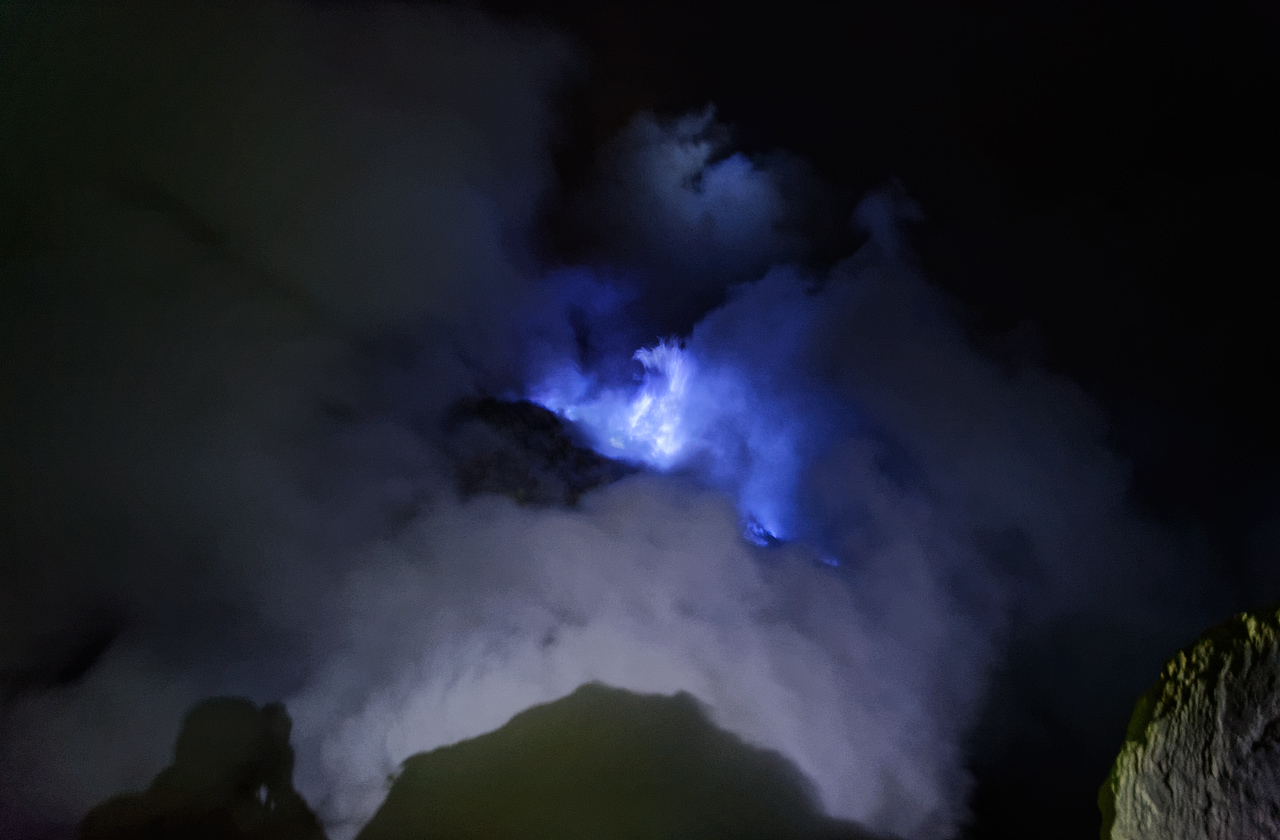
The Blue Fire: actually up close |
